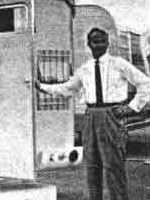From today's paper. Mike, looks like you can order seeds and give them a try!
http://www.star-telegram.com/629/story/193626.html
Tuesday, Aug 7, 2007
Posted on Tue, Aug. 07, 2007
Think you can stand the heat? The ghost chile begs to differ
By ANNA M. TINSLEY
Star-Telegram Staff Writer
Texans love their peppers. The hotter the better.
Habaneros. Jalapeños. Serranos. Green chiles.
But apparently, that love of spicy things -- and Texans' confidence that they can handle the hottest of the hottest -- may not even be in the same category as a pepper grown on the other side of the world.
In India lies the newly declared "hottest pepper in the world" - known as the bhut jolokia.
They call it the "ghost chile."
"It is so hot you can't even imagine," a farmer in India said. "When you eat it, it's like dying."
But some Texans are up for the challenge.
Fort Worth chef Tim Love tried to get his hands on some of these peppers a few years ago but couldn't find any.
"The suppliers couldn't get it. Most of them hadn't even heard of it," said Love, owner of Lonesome Dove Western Bistro, Duce and the Love Shack. "I wanted it because no one else had it and I like to do things no one else has.
"I hear it's pretty hot."
Texas heat
Peppers have long been revered in Texas -- flavoring hot sauces, soups, breads, jam and more.
So much so, lawmakers even named the jalapeño the official state pepper and the chiltepin the state native pepper.
Nearly every year, Fort Worth is the site of Zest Fest, an event hosted by Chile Pepper magazine where locals can taste and buy some of the hottest sauces around.
In Fort Worth, Mike Smith offers a hot delicacy at his Paris Coffee Shop: A house brand hot sauce known to spice nearly anything up.
"It's warm enough," he says modestly of the sauce that touts jalapeños and Louisiana peppers. "We keep the hot sauce in the display case and people buy it by the case.
"People here like to have a little kick to whatever they're eating."
But age catches up with a person, Smith said.
And that's why he doesn't think he'd be too interested in tasting the "ghost chile" himself.
"For me, it would be too hot," he said. "But there's some people out here who could probably eat it.
"If it's hotter than a habanero, I don't know if there's a container they can put it in where it wouldn't rust the lid."
Eclipsing habaneros
Experts rate peppers on how hot they are.
A regular jalapeño, for instance, measures from 2,500 to 8,000 on the Scoville scale, which measures a pepper's heat.
The pepper previously known as the hottest, the Red Savina habanero, rated 580,000 Scoville units.
But that's nothing compared with the bhut jolokia, whose 1,001,304 Scoville units easily make it the spiciest chile in the world, according to Guinness World Records.
It's said that the pepper is so hot that eating just a sliver of it can cause your eyes to water and nose to run.
The pepper is grown in northeast India, and only small quantities have been shipped out each year.
But with the new title of world's hottest, many hope the pepper will be more available worldwide.
Love, for instance, is known for his skill with peppers, having won a recent chile battle over Food Network's Iron Chef Masaharu Morimoto.
And while he hasn't been able to get any bhut jolokias, he was able to get about four ounces of a paste made from them.
"It was stinging," he said.
He used the paste in big dishes -- such as stew -- to make sure the pepper wasn't too hot.
"The idea is to use everything in moderation," he said. "Take the chile and use its flavors, not just its heat."
This report includes material from The Associated Press.
TAKING MEASURE
The heat value of a pepper is measured in Scoville units by calculating its content of capsaicin, the chemical that makes a chile spicy.
Bhut jolokia (ghost chile, above): 1,001,304
Red Savina habanero: 580,000
Thai hot: 60,000
Jalapeño: 2,500-8,000
Tabasco sauce: 2,500-5,000
Figures are approximate. Sources: Chili Pepper Institute at New Mexico State University, The Associated Press
TRY IT FOR YOURSELF
You can order seeds of this pepper online from New Mexico State University's Chile Pepper Institute.
SO HOW HOT IS IT?
Associated Press reporter Tim Sullivan decided there was only one way to find out if the bhut jolokia pepper was truly hot.
He ate one.
"Hotter than anything I'd ever eaten," he wrote. "My tongue burned, I began to cough. I knew I'd have to eat quickly, or I wouldn't be able to finish it. So I took another bite, and chewed. Then another. I ate down to the stem. I swallowed."
That's when the full effect of the pepper kicked in.
"My eyes watered uncontrollably and my nose ran. I felt like I was gargling with acid. My hands quivered. As the minutes passed, the pain grew worse," he wrote. "I shoveled in yogurt: No relief. I chewed bread: Nothing.
"My head felt like it was expanding. My ears felt as if hot liquid was draining from them. Picture one of those old Tom and Jerry cartoons, with steam blasting from Tom's ears as a train whistle blows. That was me."
It was about 20 minutes before Sullivan could talk.
Then he called his wife. Her thoughts?
"She laughed at me."
-- The Associated Press
Chile Heads - New Hottest Pepper
3 posts
• Page 1 of 1
-

Loader - Platinum Donating Member
- Posts: 1584
- Images: 245
- Joined: Tue Apr 26, 2005 2:33 pm
- Location: Fort Worth, Texas

I have the Red Savina... but it's not quite ripe yet... 580K scoville units.
I'm not sure I'm ready for something quite that hot.
Hey Laredo, are you out there? Are you ready for a Bhut Jolokia?

Mike...
The quality is remembered long after the price is forgotten, so build your teardrop with the best materials...
-

mikeschn - Site Admin
- Posts: 19202
- Images: 475
- Joined: Tue Apr 13, 2004 11:01 am
- Location: MI
